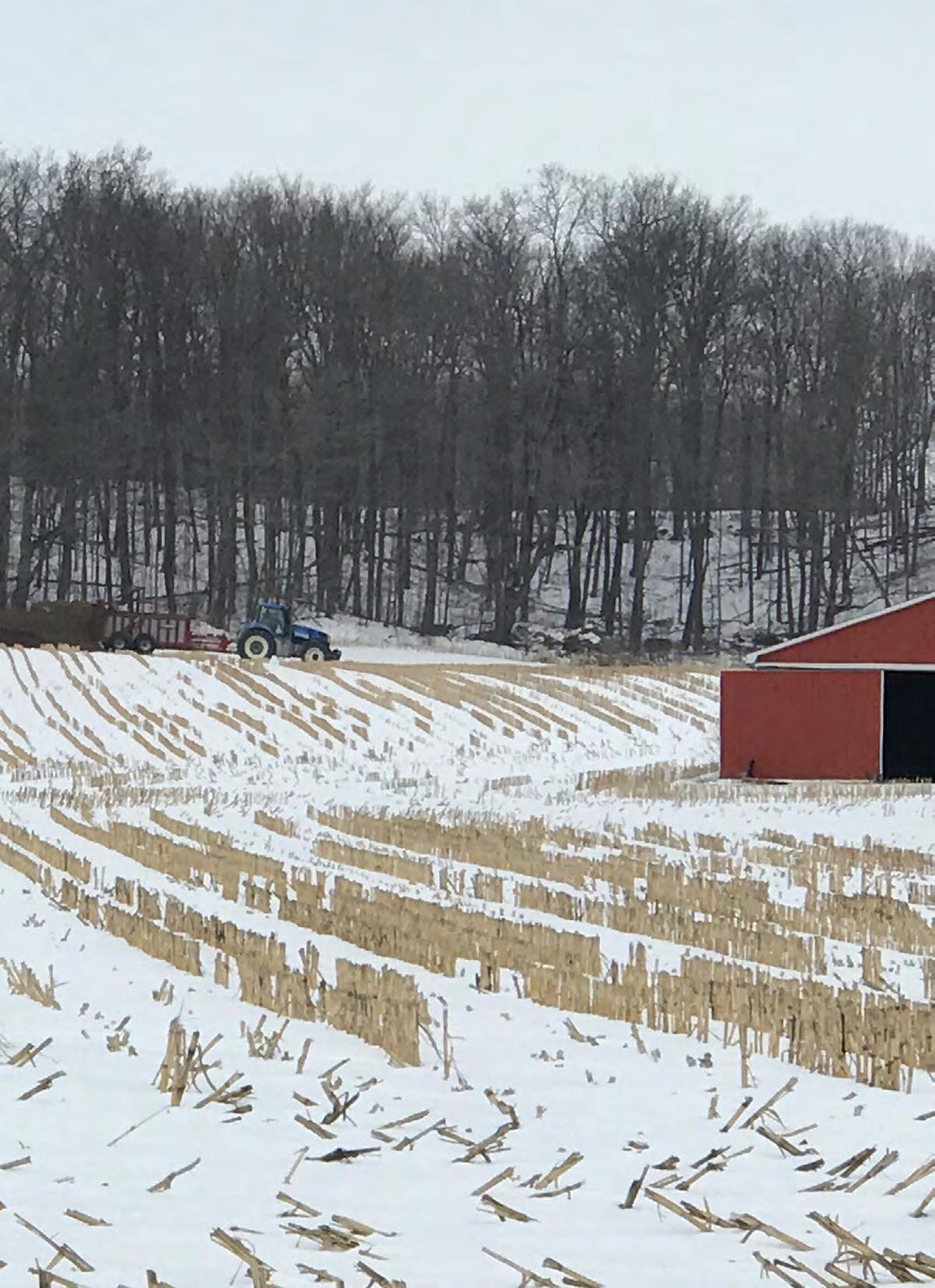
4 minute read
Manure management
from 2022-Early Spring
by MilkProducer
PLANNING IS KEY TO MAXIMIZE THE BENEFITS OF SOLID MANURE
Contingency planning helps avoid winter spreading, nutrient loss, risk to water quality
By Lilian Schaer CONTRIBUTOR
The risk to the environment and water quality from manure application on frozen or snow-covered ground is considerable. When fields are frozen, the soil has little to no capacity to absorb moisture. With winter rain and melting events common, this means any nutrients applied late in the winter are likely to be washed away into watercourses.
Not only does that negatively impact the environment, farmers will also lose the nutrient benefits of the manure they’ve just applied. And despite popular belief, solid manure can be just as susceptible to runoff as liquid.
Good planning can help avoid these challenges, says Chad Anderson, a Lambton County livestock farmer and crop consultant who is also the current president of the Ontario Soil and Crop Improvement Association.
“Manure is a terrific resource; those who have access to it are the envy of those who don’t. But it isn’t always greener on the other side of the fencerow (because) to maximize its benefit, good nutrient maanagement planning is critical,” Anderson says. “If the last few years have shown us anything, it’s that having contingency plans in place is important to help deal with Mother Nature when things don’t go as they should.”
Work by the Timing Matters Peer to Peer committee, led by Ontario’s livestock commodity organizations in partnership with the Ontario Ministry of Agriculture, Food and Rural Affairs (OMAFRA), has shown farmers mostly likely to spread manure in the winter don’t have enough storage capacity, are challenged by wet weather that keeps them from getting manure out in the fall, or incorrectly believe there is less risk of soil compaction in the winter.
“Not having all your applications all planned for one window, having adequate storage and using temporary field storage are all good practices to have in place with solid manure so you can apply manure in a timely fashion when soil conditions permit and environmental risks are low,” Anderson adds.
To avoid winter application, determine how many days of storage you have and when you want to spread manure. If the only application window is after corn harvest, consider shifting some spreading to the spring to reduce time pressures in the fall. Adding different crops to your rotation can also provide more opportunities to spread manure at different times of the year.
Manure application in the summer after wheat harvest is a popular option, for example. So is adding a cover crop that can act like a battery to store nutrients and have additional yield or soil health benefits or even serve as a supplementary feed source for livestock in the fall.
OMAFRA’s free AgriSuite software package can help you calculate how much storage you have, as well as plan applications and crop rotations. It’s available at www. ontario.ca/agrisuite.
LOCATION IS KEY
Part of good nutrient management planning includes considering the economics of expanding manure storage capacity. That could mean building new or renting unused storage nearby if that’s an option. For solid manure, temporary in-field storage is an approved solution for bedded-pack manure from cow or heifer barns or even calf hutches.
To minimize manure’s impact on water and neighbouring properties, it’s important to pick the right on-farm spot for temporary in-field storage.
The more bedding is in the manure, the more likely it will stay where you’ve placed it. Manure with high nutrient levels is best stored on a concrete pad instead of directly on the ground so any runoff can be collected or even prevented entirely by covering the storage area.
Sandy or light-textured soils have higher nitrogen leaching risks. Avoid tiled fields or ensure the temporary storage pile is at least three metres (10 feet) away from the closest tile and isn’t placed near exposed bedrock.
Keep your temporary storage as far away from your closest neighbours as possible, at least 100 metres from the edge of the field or 125 metres from the nearest residential building, which is equal to about a two- to three-minute walk under normal conditions. This same approach applies to rivers, streams, catch basins or areas known to have water flow during a thaw or heavy rains. Keep in mind, a distance of about 150 metres will help keep manure out of water sources.
In-field storage isn’t a long-term solution; manure stored this way temporarily should be applied to the land during the next available growing season.
More information about manure stewardship and longterm nutrient management options is available at https:// www.farmfoodcareon.org/timing-matters/.
Lilian Schaer
is a freelance agricultural journalist, writer and communications professional based in Guelph, Ont. She was born in Switzerland and raised on a dairy farm in Grey County. Follow her on Twitter @foodandfarming.
This article is provided by Farm & Food Care Ontario as part of the Timing Matters project. The project is funded by the Ontario Ministry of Agriculture, Food and Rural Affairs.





